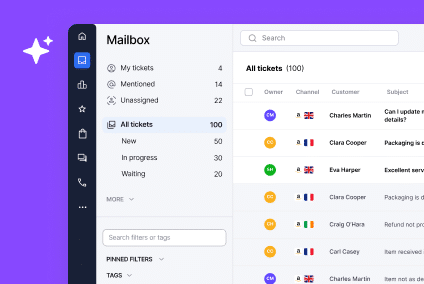The digital transformation of retail is no longer an option but a strategic necessity. In 2025, with online sales expected to represent nearly 25% of total retail sales globally and eCommerce growing at over 13% annually compared to just 4% for in-store sales, traditional retailers are discovering that opening an online store isn’t just about expanding reach, it’s about future-proofing their business.
If you’re used to running a brick-and-mortar shop, the thought of opening an online store may seem daunting. But with your company already up and running, much of the foundation is already established. Traditional retailers moving online are already knowledgeable about their business plans, products, brand, and current inventory. With these insights, you already have a significant head start on setting up your online store.
Follow these updated steps for 2025, and your eCommerce sales will be growing rapidly in no time!
Why Make the Move to Open an Online Store?
The landscape of retail has fundamentally shifted, creating unprecedented opportunities for traditional retailers ready to embrace digital commerce. Starting an online retail business is no longer just about adapting to change, it’s about capitalizing on massive market growth and changing consumer behaviors.
Current market data reveals compelling reasons for traditional retailers to open a store online:
Market Growth and Consumer Behavior
By 2025, global eCommerce sales are projected to reach $6.86 trillion, representing an 8.37% increase from 2024. This growth trajectory shows no signs of slowing, with projections indicating $8 trillion by 2027. Currently, 2.77 billion people shop online globally, representing 33% of the world’s population.
More importantly for traditional retailers, consumers increasingly embrace omnichannel shopping. Recent studies show that 40% of online browsers become in-store buyers within 48 hours, while 83% of consumers research online before visiting physical stores. This means opening an online store doesn’t cannibalize your physical business but enhances it.
Competitive Necessity
The data is clear: businesses that don’t establish an online presence risk losing market share. Annual growth rates for in-store sales hover around 4%, while eCommerce sales grow at nearly 13%. With an estimated 12-24 million eCommerce stores operating globally, the competitive landscape demands digital participation.
Operational Advantages
How to become an online retailer offers several strategic advantages beyond sales growth:
- Lower operational costs: Online stores typically cost less to maintain than physical locations
- 24/7 availability: Serve customers outside traditional business hours
- Geographic expansion: Reach customers beyond your local market
- Data insights: Comprehensive analytics on customer behavior and preferences
- Inventory efficiency: Better demand forecasting and inventory management
How to Open an Online Store: Step-by-Step Guide for 2025
With suppliers and inventory already in place, the process of opening an online store is significantly simplified for traditional retailers. We’ve refined this down to eight essential steps, updated for 2025’s market conditions.
1. Choose the Right eCommerce Platform
The first and most crucial step is selecting the platform you’ll use to launch your online store. The best option for your business depends on your team’s technical expertise, budget, and growth objectives.
Building your own store in-house requires a dedicated team of engineers, which is impractical for most businesses. This leaves three main approaches:
Hosted eCommerce Platforms
Platforms like Shopify and BigCommerce require minimal technical knowledge and are designed for quick setup. Costs typically range from $29-299 per month, depending on features and scale. With hosted platforms, your store infrastructure is managed for you, including hosting, security, and software updates.
Shopify remains the market leader with over 8,000 apps and excellent scalability options. BigCommerce offers strong built-in features that reduce dependence on third-party apps, making it ideal for growing businesses that need comprehensive functionality out of the box.
Open-Source eCommerce Platforms
For retailers with developer resources, free open-source options like WooCommerce and PrestaShop offer complete customization control. WooCommerce, built on WordPress, powers more websites than any other eCommerce platform and integrates seamlessly with existing WordPress sites.
These platforms require technical skills to implement but offer unlimited customization potential and no monthly platform fees.
WordPress Integration
If you already operate a WordPress website or blog, WooCommerce provides the most seamless transition to eCommerce functionality. This approach leverages your existing content and SEO authority while adding full online store capabilities.
Pro Tip: Contact your suppliers to determine if they use APIs or platform-specific integrations (like Shopify apps) for product data synchronization. Automated product information sync can significantly influence your platform choice and reduce long-term maintenance overhead.
2. Connect or Purchase a Domain
Domain selection plays a crucial role in brand consistency and customer trust. If you don’t already own a domain, purchase one through established registrars like GoDaddy, NameCheap, or Google Domains.
For optimal brand consistency, secure a domain featuring your business name. This builds trust with existing customers and appeals to loyal clientele who already know your brand. Unless you have an extremely sought-after name, domains typically cost $10-15 annually.
For open-source platforms, domain connection requires developer assistance. Hosted platforms like Shopify and BigCommerce offer simple domain connection tools that non-technical users can manage independently.
Additional Considerations for 2025:
- SSL certificates: Essential for security and SEO rankings (most platforms include these automatically)
- Email addresses: Professional email addresses using your domain enhance credibility
- Subdomain strategy: Consider whether to use a subdomain (shop.yourbusiness.com) or primary domain (yourbusiness.com) based on your overall web presence
3. Organize Your Shipping Strategy
Shipping strategy significantly impacts customer satisfaction and operational efficiency. With 75% of consumers expecting free delivery (even on orders under $50), shipping decisions directly affect competitiveness.
Free Shipping Analysis
Before committing to free shipping, analyze whether your current retail prices can absorb shipping costs. Calculate shipping expenses for your:
- Largest and heaviest products: Determine maximum shipping costs
- Smallest and lightest items: Establish minimum shipping expenses
- Average order composition: Understand typical customer purchases
This analysis reveals whether free shipping is financially viable at current price points or requires price adjustments.
Shipping Strategy Options
Consider these approaches based on your business goals:
- Free shipping with minimum order: Encourages larger purchases while managing costs
- Tiered shipping rates: Different rates based on order value, location, or delivery speed
- Local delivery options: Leverage your physical location for a competitive advantage
- Click-and-collect: Allow online ordering with in-store pickup, driving foot traffic
2025 Shipping Trends
Modern consumers expect fast, flexible delivery options:
- Same-day delivery: 32% of consumers expect same-day delivery for groceries; consider for appropriate product categories
- Sustainable shipping: Growing demand for eco-friendly packaging and carbon-neutral delivery options
- Multiple delivery options: Provide choices including home delivery, pickup points, and in-store collection
4. Structure Your Website for Success
Creating a well-structured website is fundamental to both user experience and search engine optimization. Don’t take shortcuts with thin content or poor navigation, as this will harm both search rankings and customer experience.
Essential Website Structure
Include these core pages and sections:
- Homepage: Clear value proposition and easy navigation to products
- Product categories: Logical organization that mirrors how customers think about your products
- About Us: Your story, values, and why customers should trust you
- Contact information: Multiple ways for customers to reach you
- Customer service: FAQ, return policy, and support information
- Legal pages: Privacy policy, terms and conditions, shipping information
User Experience Optimization
Design your website like your physical store: well-organized, easy to navigate, with your best products prominently displayed. Mobile optimization is crucial, as smartphones account for nearly 80% of retail website visits in 2025.
2025 Web Standards
- Page speed: Fast loading times are crucial for both user experience and SEO
- Mobile-first design: Ensure your site works perfectly on smartphones and tablets
- Accessibility: Design for users with disabilities to expand your customer base
- Trust signals: Customer reviews, security badges, and clear contact information
Most platforms like Shopify provide free templates for privacy policies and terms of service, simplifying legal compliance.
5. Set Up Analytics and Tracking
One of the most significant advantages of how to start an online retail business compared to traditional retail is the wealth of actionable data available. Unlike physical stores, online retailers can track customer behavior with precision.
Google Analytics 4 Implementation
Set up Google Analytics 4 to track:
- Traffic sources: Understanding where customers discover your store
- Customer behavior: How visitors navigate your site and what interests them
- Conversion paths: The journey from first visit to purchase
- Product performance: Which items generate the most interest and sales
- Geographic data: Where your customers are located eCommerce-Specific Metrics
Monitor key performance indicators that matter for online retail:
- Conversion rate: Percentage of visitors who make purchases
- Average order value: Typical purchase amount per transaction
- Cart abandonment rate: How many customers add items but don’t complete purchases
- Customer lifetime value: Long-term value of customer relationships
- Return customer rate: How often customers make repeat purchases
Advanced Analytics for 2025
Modern analytics platforms offer sophisticated insights:
- Predictive analytics: Forecast demand and identify trending products
- Customer segmentation: Group customers by behavior, preferences, and value
- Attribution modeling: Understand which marketing channels drive the best results
- Real-time reporting: Monitor performance and respond quickly to trends
This information proves invaluable for advertising spend allocation, inventory planning, and product promotion decisions.
6. Create Compelling Product Pages
Whether using automated feeds, CSV files, or manual uploads, product pages are where browsers become buyers. In 2025, with consumers having access to countless options, product page quality often determines success.
Essential Product Page Elements
- High-quality images: Multiple angles, zoom functionality, and lifestyle photos showing products in use
- Video content: Product demonstrations, unboxing, or 360-degree views
- Detailed descriptions: Comprehensive information that answers customer questions
- Clear call-to-action: Prominent “Buy Now” or “Add to Cart” buttons
- Structured content: Use headings, bullet points, and easy-to-scan formatting
- Specifications: Technical details, dimensions, materials, and compatibility information
- SEO optimization: Include relevant keywords naturally throughout the page
Content Strategy
Balance comprehensive information with readability. Provide enough detail to build confidence while maintaining engaging, scannable content. Consider your brand voice and how it should come through in product descriptions.
Customer Communication
Offer multiple ways for customers to ask questions about products:
- Live chat: Real-time assistance during shopping
- FAQ sections: Address common questions proactively
- Customer reviews: Social proof from previous buyers
- Comparison tools: Help customers choose between similar products
2025 Product Page Trends
- AI-powered recommendations: Suggest related or complementary products
- Augmented reality: Allow customers to visualize products in their space
- User-generated content: Feature customer photos and videos
- Personalization: Tailor content based on customer behavior and preferences
7. Implement Secure Payment Processing
Payment processing is one of the most critical components of opening an online store. Security, reliability, and customer convenience all factor into payment gateway selection.
Payment Gateway Options
Hosted platforms like Shopify and BigCommerce offer integrated payment processing:
- Shopify Payments: Built-in processing with competitive rates and seamless integration
- BigCommerce payments: Multiple processor options without additional transaction fees
- PayPal: Widely trusted option available across all platforms
- Stripe: Popular choice for its developer-friendly features and global reach
Payment Method Diversity
Offer multiple payment options to accommodate customer preferences:
- Credit and debit cards: Essential for most customers
- Digital wallets: Apple Pay, Google Pay, and others for mobile convenience
- Buy Now, Pay Later: Services like Klarna, Afterpay, and Affirm (BNPL transactions reached $133 billion in 2024)
- Bank transfers: For larger purchases or B2B customers
- Cryptocurrency: Emerging option for tech-savvy customers
Security Considerations
Ensure your payment processing meets current security standards:
- PCI DSS compliance: Required for handling credit card information
- SSL encryption: Protect customer data during transmission
- Fraud protection: Built-in tools to detect and prevent fraudulent transactions
- Two-factor authentication: Additional security for admin access
8. Develop Your eCommerce Marketing Strategy
Successfully starting an online retail business requires driving relevant traffic to your new store. Without effective marketing, even the best online store won’t generate sales.
Multi-Channel Marketing Approach
Develop a comprehensive marketing strategy that includes:
Search Engine Optimization (SEO)
- Keyword research: Identify terms your customers use to find products
- On-page optimization: Optimize product pages, categories, and blog content
- Technical SEO: Ensure your site loads quickly and functions properly
- Content marketing: Create valuable content that attracts and educates customers
Social Media Marketing
- Platform selection: Focus on platforms where your customers spend time
- Content strategy: Share product highlights, behind-the-scenes content, and customer stories
- Social commerce: Sell directly through Instagram, Facebook, and TikTok
- Influencer partnerships: Collaborate with relevant influencers in your industry
Paid Advertising
- Google Ads: Target customers searching for your products
- Social media ads: Reach customers on their preferred platforms
- Retargeting campaigns: Re-engage visitors who didn’t make initial purchases
- Email marketing: Nurture relationships with existing and potential customers
2025 Marketing Trends
- AI-powered personalization: Customize marketing messages based on customer behavior
- Video-first content: Leverage short-form video content across platforms
- Voice search optimization: Optimize for voice search queries
- Sustainability messaging: Highlight eco-friendly practices and products
9. Implement Comprehensive Customer Service
Providing exceptional customer service remains crucial for online retail success. In the digital environment, customer service quality directly impacts reviews, repeat purchases, and brand reputation.
Why Customer Service Matters for Online Stores
Poor customer service leads to negative reviews, which harm both search engine rankings and customer trust. Negative reviews can damage your chances of winning prominent positions on Google and marketplaces like Amazon and eBay.
Conversely, excellent customer service generates positive reviews, builds customer loyalty, and creates word-of-mouth marketing that drives organic growth.
Customer Service Infrastructure
Implement systems that enable fast, helpful responses:
Multi-Channel Support
- Email support: Professional, detailed responses to complex inquiries
- Live chat: Real-time assistance during shopping and checkout
- Phone support: Direct contact for urgent issues
- Social media: Monitor and respond to questions and complaints on social platforms
- Self-service options: FAQ sections, knowledge bases, and video tutorials
Integration and Efficiency
eCommerce customer service software like eDesk can significantly improve your support capabilities by:
- Centralizing communications: All customer inquiries from multiple channels in one interface
- Order integration: Automatic matching of customer queries with order details and history
- Response automation: Template responses for common questions
- Performance tracking: Metrics on response times, resolution rates, and customer satisfaction
- Marketplace integration: Seamless support across all selling channels
eDesk integrates with every major eCommerce platform and marketplace, ensuring you can provide consistent, professional customer service regardless of where customers contact you. This unified approach simplifies support management and enables faster response times.
Customer Service Best Practices for 2025
- Proactive communication: Send order updates, shipping notifications, and delivery confirmations
- Personalized responses: Use customer data to provide relevant, helpful assistance
- Quick response times: Aim for same-day responses to email and immediate response to live chat
- Problem resolution: Empower customer service representatives to solve problems quickly
- Follow-up: Check customer satisfaction after resolving issues
Advanced Considerations for 2025
Omnichannel Integration
Modern customers expect seamless experiences across all touchpoints. Integrate your online store with your physical location to create a unified brand experience:
- Click-and-collect: Allow online ordering with in-store pickup
- Inventory synchronization: Real-time inventory updates across all channels
- Customer data unification: Single customer profiles across online and offline interactions
- Cross-channel marketing: Coordinate marketing messages across all customer touchpoints
Sustainability and Social Responsibility
Consumer expectations increasingly include environmental and social responsibility:
- Sustainable packaging: Use eco-friendly packaging materials and minimal packaging
- Carbon-neutral shipping: Offer carbon offset options for deliveries
- Ethical sourcing: Highlight responsible sourcing and manufacturing practices
- Local community involvement: Connect your online presence with local community engagement
Technology Integration
Leverage emerging technologies to enhance the customer experience:
- Artificial intelligence: Personalized product recommendations and chatbot assistance
- Augmented reality: Virtual try-on experiences and product visualization
- Voice commerce: Optimize for voice search and voice-activated purchases
- Internet of Things: Connected products and smart reordering capabilities
Final Thoughts
Opening an online store in 2025 represents one of the most significant opportunities for traditional retailers to expand their reach, increase revenue, and future-proof their businesses. With eCommerce continuing to grow at rates far exceeding traditional retail, the question isn’t whether to go online, but how quickly you can establish a strong digital presence.
The steps outlined in this guide provide a comprehensive roadmap for traditional retailers ready to embrace digital commerce. By leveraging your existing business knowledge, supplier relationships, and customer base, you can build an online store that complements and enhances your physical location.
Remember that successful eCommerce isn’t just about technology; it’s about creating exceptional customer experiences that build loyalty and drive repeat business. Whether customers discover you online or in-store, consistent quality and service will determine your long-term success.
Start with a solid foundation, invest in the right tools and platforms, and focus on serving your customers well across all channels. With dedication and the right approach, your online store can become a significant driver of business growth and customer satisfaction.
Consider partnering with platforms like eDesk to ensure your customer service capabilities match the quality of your products and brand experience. In the competitive world of eCommerce, superior customer service often makes the difference between one-time buyers and lifelong customers.
Book a free demo today to learn more about how eDesk can help you make the most of online selling opportunities.




